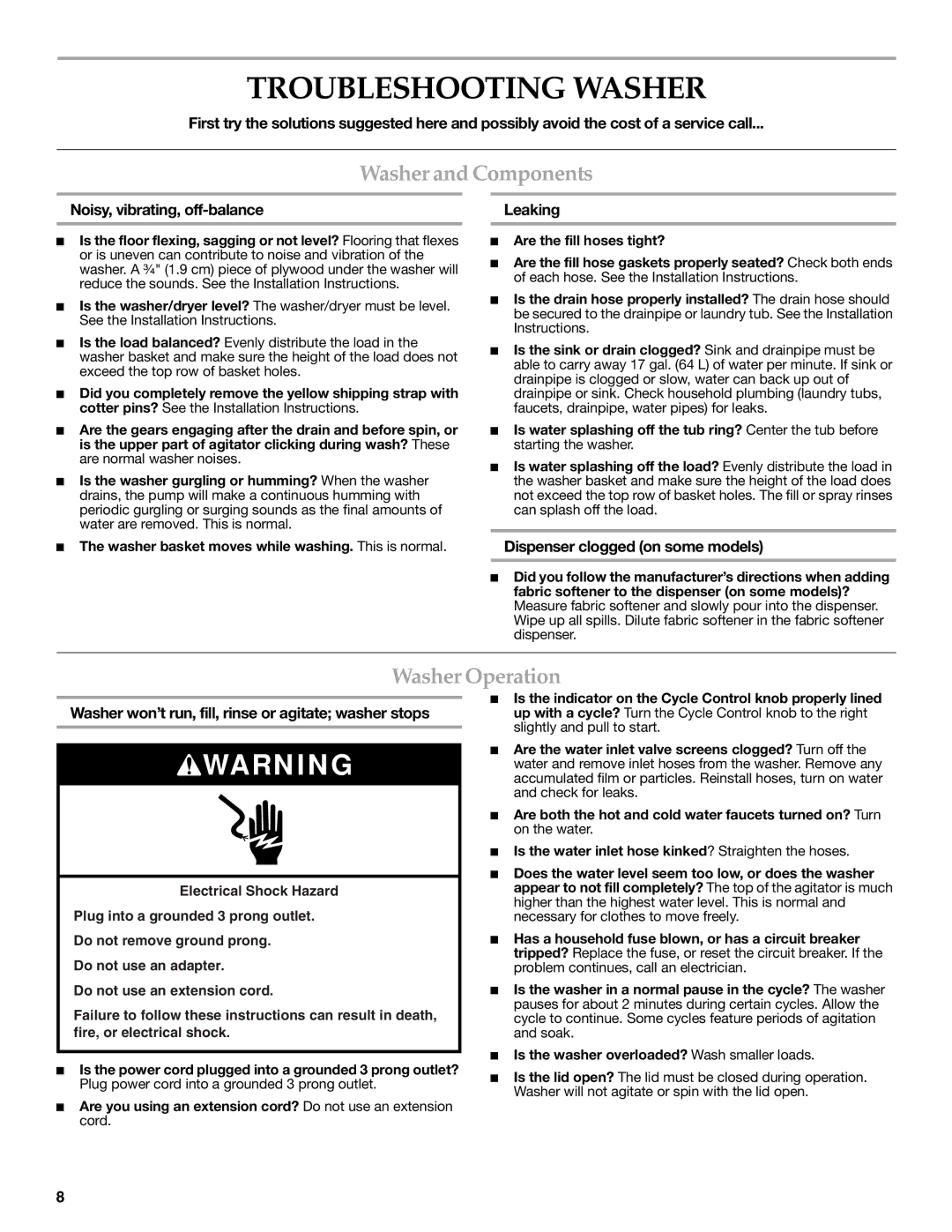
TROUBLESHOOTING WASHER
First try the solutions suggested here and possibly avoid the cost of a service call...
Washer and Components
Noisy, vibrating, |
| Leaking |
■Is the floor flexing, sagging or not level? Flooring that flexes or is uneven can contribute to noise and vibration of the washer. A ³⁄₄" (1.9 cm) piece of plywood under the washer will reduce the sounds. See the Installation Instructions.
■Is the washer/dryer level? The washer/dryer must be level. See the Installation Instructions.
■Is the load balanced? Evenly distribute the load in the washer basket and make sure the height of the load does not exceed the top row of basket holes.
■Did you completely remove the yellow shipping strap with cotter pins? See the Installation Instructions.
■Are the gears engaging after the drain and before spin, or is the upper part of agitator clicking during wash? These are normal washer noises.
■Is the washer gurgling or humming? When the washer drains, the pump will make a continuous humming with periodic gurgling or surging sounds as the final amounts of water are removed. This is normal.
■Are the fill hoses tight?
■Are the fill hose gaskets properly seated? Check both ends of each hose. See the Installation Instructions.
■Is the drain hose properly installed? The drain hose should be secured to the drainpipe or laundry tub. See the Installation Instructions.
■Is the sink or drain clogged? Sink and drainpipe must be able to carry away 17 gal. (64 L) of water per minute. If sink or drainpipe is clogged or slow, water can back up out of drainpipe or sink. Check household plumbing (laundry tubs, faucets, drainpipe, water pipes) for leaks.
■Is water splashing off the tub ring? Center the tub before starting the washer.
■Is water splashing off the load? Evenly distribute the load in the washer basket and make sure the height of the load does not exceed the top row of basket holes. The fill or spray rinses can splash off the load.
■The washer basket moves while washing. This is normal.
Dispenser clogged (on some models)
■Did you follow the manufacturer’s directions when adding fabric softener to the dispenser (on some models)? Measure fabric softener and slowly pour into the dispenser. Wipe up all spills. Dilute fabric softener in the fabric softener dispenser.
Washer Operation
Washer won’t run, fill, rinse or agitate; washer stops
![]() WARNING
WARNING
Electrical Shock Hazard
Plug into a grounded 3 prong outlet.
Do not remove ground prong.
Do not use an adapter.
Do not use an extension cord.
Failure to follow these instructions can result in death, fire, or electrical shock.
■Is the power cord plugged into a grounded 3 prong outlet? Plug power cord into a grounded 3 prong outlet.
■Are you using an extension cord? Do not use an extension cord.
■Is the indicator on the Cycle Control knob properly lined up with a cycle? Turn the Cycle Control knob to the right slightly and pull to start.
■Are the water inlet valve screens clogged? Turn off the water and remove inlet hoses from the washer. Remove any accumulated film or particles. Reinstall hoses, turn on water and check for leaks.
■Are both the hot and cold water faucets turned on? Turn on the water.
■Is the water inlet hose kinked? Straighten the hoses.
■Does the water level seem too low, or does the washer appear to not fill completely? The top of the agitator is much higher than the highest water level. This is normal and necessary for clothes to move freely.
■Has a household fuse blown, or has a circuit breaker tripped? Replace the fuse, or reset the circuit breaker. If the problem continues, call an electrician.
■Is the washer in a normal pause in the cycle? The washer pauses for about 2 minutes during certain cycles. Allow the cycle to continue. Some cycles feature periods of agitation and soak.
■Is the washer overloaded? Wash smaller loads.
■Is the lid open? The lid must be closed during operation. Washer will not agitate or spin with the lid open.
8
